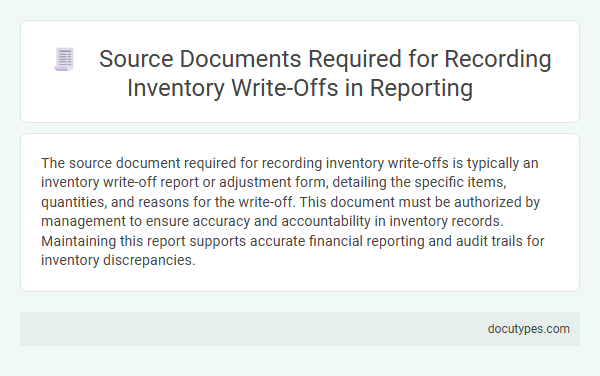The source document required for recording inventory write-offs is typically an inventory write-off report or adjustment form, detailing the specific items, quantities, and reasons for the write-off. This document must be authorized by management to ensure accuracy and accountability in inventory records. Maintaining this report supports accurate financial reporting and audit trails for inventory discrepancies.
Introduction to Inventory Write-Offs
Inventory write-offs occur when inventory is deemed obsolete, damaged, or unsellable, necessitating removal from accounting records. Correct documentation is essential to maintain financial accuracy and comply with audit requirements.
- Inventory Adjustment Form - Serves as the primary source document detailing the quantity and reason for the write-off.
- Approval Authorization - Confirms management's consent for the write-off to ensure internal control compliance.
- Physical Inventory Count - Provides evidence supporting the discrepancy between recorded and actual inventory levels.
Accurate source documents form the foundation for properly recording inventory write-offs in accounting systems.
Importance of Accurate Source Documentation
Accurate source documentation is essential for recording inventory write-offs to ensure proper tracking and accountability. You must use reliable source documents to validate the reasons and amounts involved in the write-off process.
- Inventory Write-Off Report - A detailed report specifying the quantity and value of inventory being written off.
- Approval Authorization - Formal approval from management confirming the legitimacy of the write-off.
- Supporting Evidence - Documentation such as inspection reports, damage assessments, or obsolescence records supporting the write-off claim.
Inventory Write-Off Authorization Forms
| Aspect | Description |
|---|---|
| Source Document Name | Inventory Write-Off Authorization Form |
| Purpose | Official documentation to approve inventory write-offs due to damage, loss, obsolescence, or theft |
| Key Information Included |
|
| Role in Accounting | Serves as primary source document for recording the financial impact of inventory write-offs in accounting systems |
| Control and Compliance | Ensures proper internal controls and audit trail for inventory adjustments, complying with company policies and regulatory standards |
Stock Count Sheets and Reconciliation Reports
Source documents are essential for accurately recording inventory write-offs, ensuring transparency and accountability. Stock count sheets provide a detailed record of physical inventory counts conducted during stocktaking.
Reconciliation reports compare the physical counts with inventory records to identify discrepancies requiring write-offs. You should retain both stock count sheets and reconciliation reports as official documentation for all inventory adjustments.
Inventory Adjustment Memos
Inventory Adjustment Memos serve as the primary source document required for recording inventory write-offs. These memos provide detailed information about the quantity and reason for the write-off, ensuring accurate inventory accounting. Proper documentation through Inventory Adjustment Memos supports audit trails and financial reporting compliance.
Supporting Correspondence and Internal Memos
Source documents required for recording inventory write-offs primarily include supporting correspondence and internal memos that detail the reasons behind the write-off. These documents provide essential evidence to justify the adjustment in inventory records.
Supporting correspondence such as emails or letters from department heads or auditors clarifies the circumstances leading to the write-off. Internal memos serve as official records, outlining approval and verification procedures needed for accurate accounting.
Damaged Goods Reports and Inspection Records
Source documents required for recording inventory write-offs primarily include Damaged Goods Reports and Inspection Records. These documents provide detailed evidence of the condition and quantity of goods deemed unfit for sale or use. Accurate documentation ensures proper accounting adjustments and supports audit trails for inventory valuation.
Credit Notes and Supplier Documentation
Credit notes serve as essential source documents when recording inventory write-offs, providing formal acknowledgment from suppliers of returned or damaged goods. These documents ensure accurate adjustments in inventory records and financial statements.
Supplier documentation, including delivery notes and correspondence, supports the validation of the credit notes and substantiates the reason for the inventory write-off. Retaining these documents is crucial for audit trails and compliance with accounting standards. You must verify that all source documents are properly authorized and accurately reflect the transaction details before processing write-offs.
Transaction Entry and General Ledger Records
Accurate source documents are essential for recording inventory write-offs to ensure proper financial reporting and audit trails. These documents support transaction entries and integrity of general ledger records.
- Inventory Write-Off Form - A detailed form specifying items, quantities, and reasons for write-off used to initiate the transaction entry process.
- Approval Documentation - Authorization from management or inventory control verifying the legitimacy of the write-off for compliance and internal controls.
- Transaction Entry Record - Digital or physical record capturing the write-off entry affecting both inventory accounts and corresponding general ledger accounts.
What Source Document Is Required for Recording Inventory Write-Offs? Infographic

